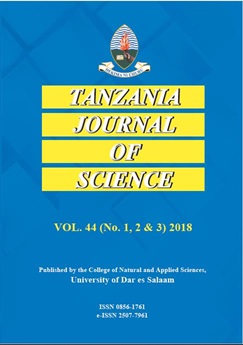Antibacterial Potency of Allium sativum, Psidium guajava, Zingiber officinale Roots against the Food Poisoning Strains (Escherichia coli 0157:H7 and Staphylococcus aureus)
DOI:
https://doi.org/10.4314/tjs.v48i4.11Abstract
Escherichia coli 0157:H7 and Staphylococcus aureus are notorious food poisoning bacteria of great effect on human health. This study determined the phytochemical constituents of ethanolic, vacuum liquid chromatography (VLC) filtrates of Allium sativum (garlic), Psidium guajava (guava), Zingiber officinale (ginger) and their antibacterial activities on E. coli 0157:H7 and S. aureus. In a laboratory-based controlled experiment, the antibacterial and inhibitory activities of the VLC filtrates in doses of 0.01, 0.02, 0.04, and 0.08g/mL were investigated on E. coli 0157:H7 and S. aureus using the agar well diffusion method and compared with a standard antibiotic. The indices of the zone of inhibition on the agar plates were subjected to analysis of variance (p = 0.01). Phytochemical analysis revealed a high concentration of glycosides, steroids, tannins, terpenoids, and the absence of flavonoids in A. sativum. P. guajava root contained a high concentration of glycosides, steroids, tannins, and terpenoids. Z. officinale possessed a high concentration of alkaloids, glycosides, flavonoids, steroids, and terpenoids. Statistically, 0.02 g/mL of Z. officinale (12.0 mm) showed a significant result to 0.04g/mL of A. sativum (14mm) at p = 0.0049 and a higher inhibition index to 0.08g/mL of P. guajava. Inhibition by 0.02g/mL of P. guajava (8.8mm) was advanced than 0.04g/mL of A. sativum (6.3 mm) on S. aureus. Recommendable inhibition of 29.3 mm and 24.0 mm on E. coli 0157:H7 and S. aureus, respectively, were expressed by 0.08 g/mL Z. officinale, which was significant to the standard 0.04 g/mL of Neomycin (Positive control) at p = 0.0067. This study indicated a reliable antibacterial activity by Z. officinale than A. sativum and P. guajava, which might have been due to the high concentration of alkaloids and flavonoids. Nevertheless, A. sativum, P. guajava, and Z. officinale are normally used as fruit and food additives in the human diet, thus can be combined to prevent food poisoning by E. coli 0157:H7 and S. aureus and their exotoxins.
Keywords: Allium sativum, Antibacterial activity, Escherichia coli 0157:H7, Psidium guajava, Staphylococcus aureus, Zingiber officinale


